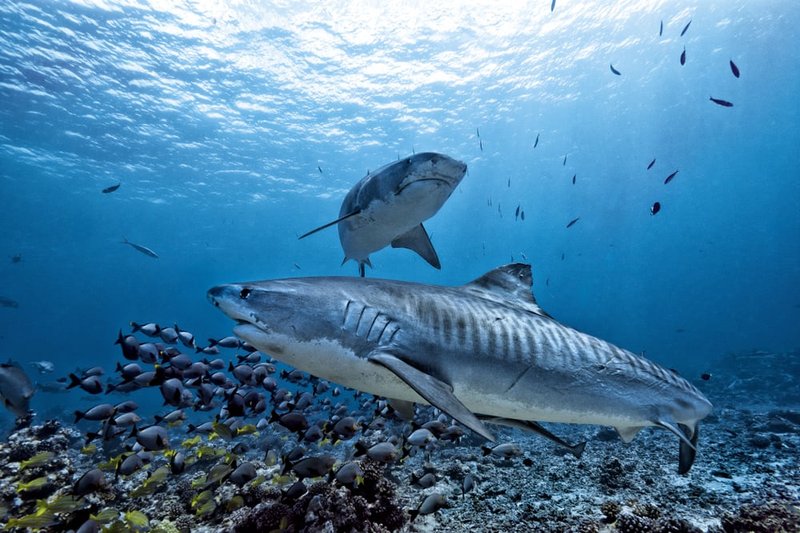
To put it simply, tiger sharks are opportunistic feeders. They consume a wide range of prey, from fish and seals to birds and even the occasional piece of trash. Yes, you read that right! This adaptability in their feeding habits plays a significant role in their survival. Let’s dive deeper into what makes the diet of the tiger shark so unique, starting with a closer look at their feeding behaviors.
What Do Tiger Sharks Eat?
Tiger sharks are known for their varied diet, which can often seem a bit wild. They eat almost anything they can catch, which contributes to their reputation as one of the ocean’s top predators. One of the most interesting aspects of their diet is the sheer diversity of prey, including:
- Fish: This includes both bony fish and smaller sharks.
- Mammals: They also enjoy feasting on seals and sea lions.
- Birds: Tiger sharks are known to take a bite out of seabirds that come too close to the water.
- Reptiles: They may even eat turtles, thanks to their powerful jaws.
- Trash: From tires to tin cans, these sharks sometimes munch on human debris in the ocean.
Honestly, it’s like they have an “all-you-can-eat” buffet in the ocean, so they take full advantage of that! This ability to eat almost anything provides them with a steady food source, especially in diverse marine environments.
How Do Tiger Sharks Hunt?
When it comes to hunting, tiger sharks have a few tricks up their fins. They often rely on stealth and surprise. Imagine a cat stalking its prey; tiger sharks do something similar. They tend to glide silently through the water, using their sharp senses to detect movement.
Tiger sharks are known to be ambush predators. They lie in wait, patiently watching for the right moment to strike. Interestingly, they often hunt at dawn or dusk when their prey is less vigilant. Here’s a little secret: they also have good night vision, which gives them an edge in low-light conditions.
Once they spot their target, they attack with incredible speed. Their powerful jaws can crush shells and bones, allowing them to consume hard-shelled prey like turtles. They rely on their sharp teeth, which are designed for slicing through flesh, to grab onto their meal effectively.
The Role of Teeth in Feeding
The teeth of a tiger shark are fascinating and essential to their feeding habits. Shaped like blades, their teeth are perfect for tearing through flesh and crushing hard-shelled prey. Let’s break it down a bit:
- Design: The teeth are serrated, like a knife, making it easier to cut through tough materials.
- Strength: Tiger sharks possess some of the strongest bite forces among sharks, allowing them to tackle larger prey.
- Replacement: Their teeth continuously grow and are replaced throughout their lifetime, so they’re always ready for action!
This unique dental arrangement allows them to adapt to a wide array of diets, ensuring they can thrive in various marine environments. It’s almost as if nature designed them with a Swiss Army knife approach to eating!
Feeding Patterns and Habits
Feeding patterns in tiger sharks can vary based on their environment, time of year, and availability of prey. They are known to be both day and night feeders, but their activity tends to peak during twilight hours. Here’s what you might find interesting:
– Seasonal Changes: In certain regions, tiger sharks may migrate in search of food, following schools of fish or other prey. For instance, during breeding seasons, you might notice them congregating in specific areas with abundant food sources.
– Social Feeding: While often solitary hunters, tiger sharks can sometimes be seen feeding alongside other sharks when a large school of fish is spotted. It’s like a feast where they share the spoils!
– Scavenging: These sharks are opportunistic feeders, meaning they don’t just rely on fresh catches. They’ll scavenge on carcasses, which helps them conserve energy and ensures they get enough to eat.
Impact on Marine Ecosystems
The tiger shark’s feeding habits play a crucial role in maintaining the balance of marine ecosystems. As apex predators, they help control populations of various species, which can prevent overpopulation and maintain healthy habitats. Here’s why that’s important:
– Biodiversity: By keeping prey populations in check, tiger sharks allow for a more diverse marine environment. This balance is essential for the health of coral reefs and other ecosystems.
– Health of Prey Species: Tiger sharks can prey on the sick, weak, or injured fish, which helps promote the overall health of fish populations. It’s nature’s way of ensuring that only the fittest survive.
– Nutrient Cycling: When tiger sharks eat different species, they help recycle nutrients back into the ecosystem through excretion, promoting the growth of marine plants and other creatures.
You might be wondering how this all ties back to the tiger shark’s unique diet, and the answer is simple: it’s all connected. Each meal contributes to the intricate web of life under the sea.
In conclusion, the diet and feeding habits of tiger sharks paint a vivid picture of resilience and adaptability in the world’s oceans. Their diverse diet, hunting techniques, and impact on marine ecosystems make them an essential part of ocean life.
When you think about these majestic creatures gliding through the water, remember that their diet is a reflection of their role in maintaining balance in the marine world. So next time you’re near the ocean, take a moment to appreciate these fascinating predators and all the intricate layers of life they support. This is one shark whose meal plan is anything but ordinary!

